child seat HONDA ODYSSEY 2023 Owners Manual
[x] Cancel search | Manufacturer: HONDA, Model Year: 2023, Model line: ODYSSEY, Model: HONDA ODYSSEY 2023Pages: 707, PDF Size: 23.9 MB
Page 11 of 707
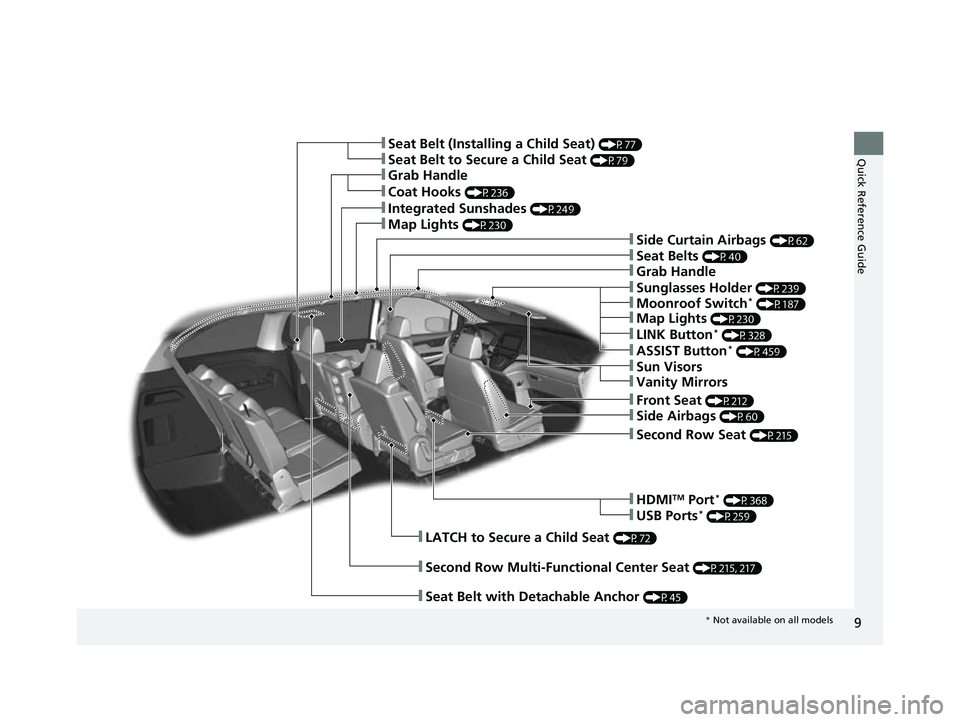
9
Quick Reference Guide
❚Seat Belts (P40)
❚Seat Belt to Secure a Child Seat (P79)
❚Seat Belt (Installing a Child Seat) (P77)
❚Side Curtain Airbags (P62)
❚Front Seat (P212)
❚Second Row Multi-Functional Center Seat (P215, 217)
❚Grab Handle
❚Sun Visors
❚Vanity Mirrors
❚Side Airbags (P60)
❚Second Row Seat (P215)
❚HDMITM Port* (P368)
❚USB Ports* (P259)
❚LATCH to Secure a Child Seat (P72)
❚Coat Hooks (P236)
❚Integrated Sunshades (P249)
❚Map Lights (P230)
❚Grab Handle
❚Seat Belt with Detachable Anchor (P45)
❚Sunglasses Holder (P239)
❚Moonroof Switch* (P187)
❚Map Lights (P230)
❚LINK Button* (P328)
❚ASSIST Button* (P459)
* Not available on all models
23 US ODYSSEY-31THR6500.book 9 ページ 2022年1月24日 月曜日 午前11時35分
Page 12 of 707
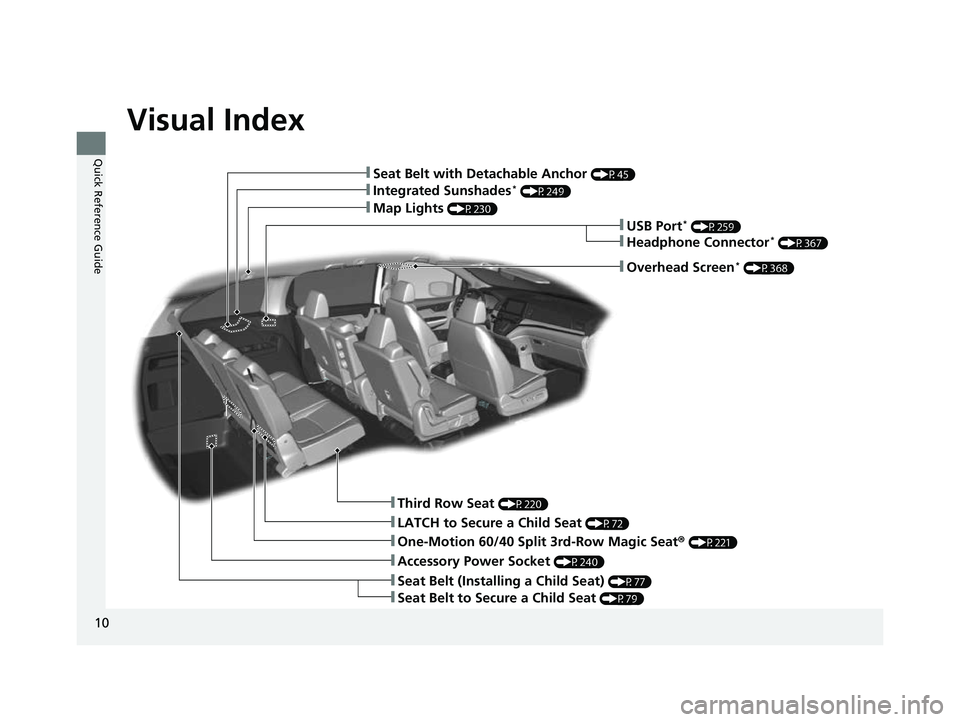
Visual Index
10
Quick Reference Guide
❚Third Row Seat (P220)
❚One-Motion 60/40 Split 3rd-Row Magic Seat® (P221)
❚Integrated Sunshades* (P249)
❚Map Lights (P230)
❚LATCH to Secure a Child Seat (P72)
❚Accessory Power Socket (P240)
❚Seat Belt (Installing a Child Seat) (P77)
❚Seat Belt to Secure a Child Seat (P79)
❚Seat Belt with Detachable Anchor (P45)
❚USB Port* (P259)
❚Headphone Connector* (P367)
❚Overhead Screen* (P368)
23 US ODYSSEY-31THR6500.book 10 ページ 2022年1月24日 月曜日 午前11時35分
Page 16 of 707
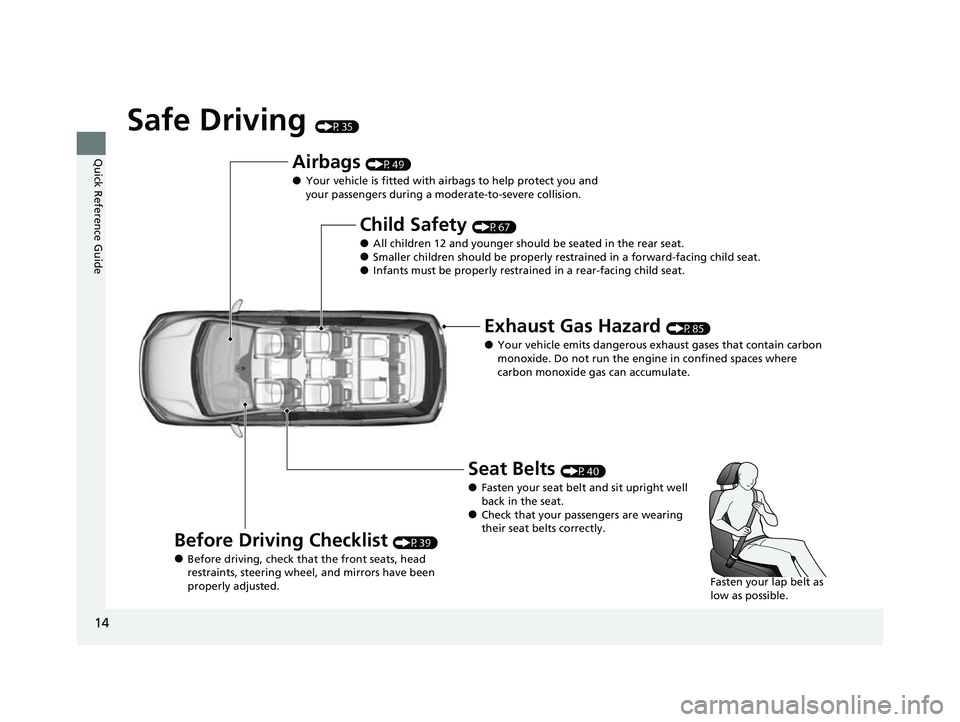
14
Quick Reference Guide
Safe Driving (P35)
Airbags (P49)
●Your vehicle is fitted with airbags to help protect you and
your passengers during a moderate-to-severe collision.
Child Safety (P67)
●All children 12 and younger should be seated in the rear seat.●Smaller children should be properly restra ined in a forward-facing child seat.●Infants must be properly restrained in a rear-facing child seat.
Exhaust Gas Hazard (P85)
●Your vehicle emits dangerous exhaust gases that contain carbon
monoxide. Do not run the engine in confined spaces where
carbon monoxide gas can accumulate.
Before Driving Checklist (P39)
●Before driving, check that the front seats, head
restraints, steering wheel, and mirrors have been
properly adjusted.
Seat Belts (P40)
●Fasten your seat belt and sit upright well
back in the seat.
●Check that your passengers are wearing
their seat belts correctly.
Fasten your lap belt as
low as possible.
23 US ODYSSEY-31THR6500.book 14 ページ 2022年1月24日 月曜日 午前11時35分
Page 37 of 707
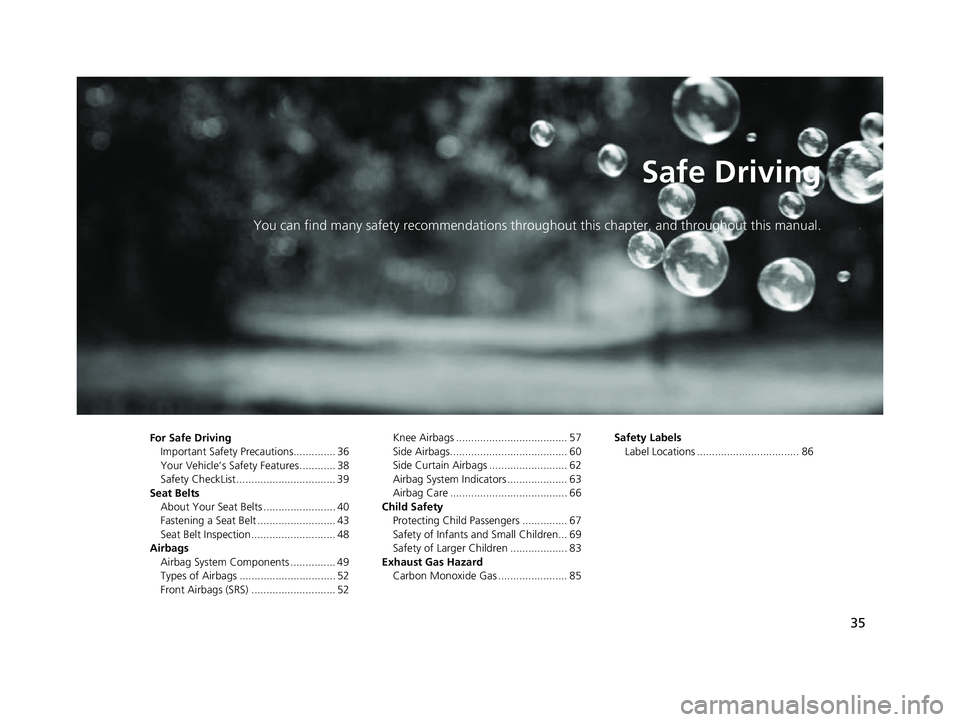
35
Safe Driving
You can find many safety recommendations throughout this chapter, and throughout this manual.
For Safe DrivingImportant Safety Precautions.............. 36
Your Vehicle’s Safety Features ............ 38
Safety CheckList ................................. 39
Seat Belts About Your Seat Belts ........................ 40
Fastening a Seat Belt .......................... 43
Seat Belt Inspection ............................ 48
Airbags Airbag System Components ............... 49
Types of Airbags ................................ 52
Front Airbags (SRS) ............................ 52 Knee Airbags ..................................... 57
Side Airbags....................................... 60
Side Curtain Airbags .......................... 62
Airbag System Indicators .................... 63
Airbag Care ....................................... 66
Child Safety Protecting Child Passengers ............... 67
Safety of Infants a nd Small Children... 69
Safety of Larger Children ................... 83
Exhaust Gas Hazard Carbon Monoxide Gas ....................... 85 Safety Labels
Label Locations .................................. 86
23 US ODYSSEY-31THR6500.book 35 ページ 2022年1月24日 月曜日 午前11時35分
Page 38 of 707
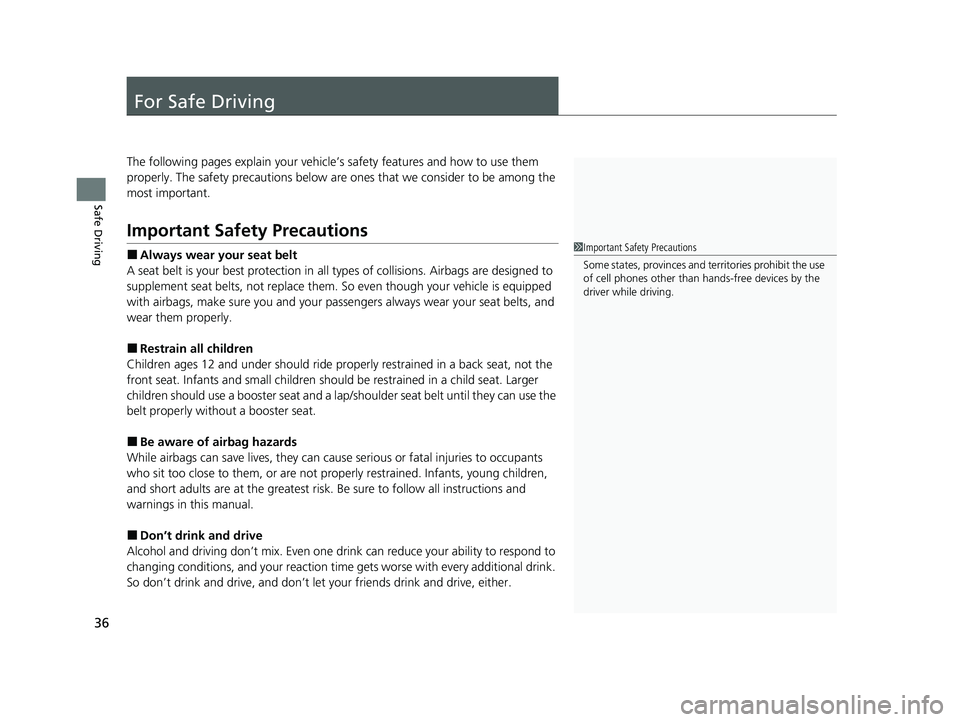
36
Safe Driving
For Safe Driving
The following pages explain your vehicle’s safety features and how to use them
properly. The safety precautions below are ones that we consider to be among the
most important.
Important Safety Precautions
■Always wear your seat belt
A seat belt is your best protection in all types of collisions. Airbags are designed to
supplement seat belts, not replace them. So even though your vehicle is equipped
with airbags, make sure you and your passengers always wear your seat belts, and
wear them properly.
■Restrain all children
Children ages 12 and under should ride properly restrained in a back seat, not the
front seat. Infants and small children shoul d be restrained in a child seat. Larger
children should use a booster seat and a lap/shoulder seat belt until they can use the
belt properly without a booster seat.
■Be aware of airbag hazards
While airbags can save lives, they can cause serious or fatal injuries to occupants
who sit too close to them, or are not prop erly restrained. Infants, young children,
and short adults are at the greatest risk. Be sure to follow all instructions and
warnings in this manual.
■Don’t drink and drive
Alcohol and driving don’t mix. Even one dr ink can reduce your ability to respond to
changing conditions, and your reaction time gets worse with every additional drink.
So don’t drink and drive, and don’t let your friends drink and drive, either.
1Important Safety Precautions
Some states, provinces and te rritories prohibit the use
of cell phones other than hands-free devices by the
driver while driving.
23 US ODYSSEY-31THR6500.book 36 ページ 2022年1月24日 月曜日 午前11時35分
Page 41 of 707
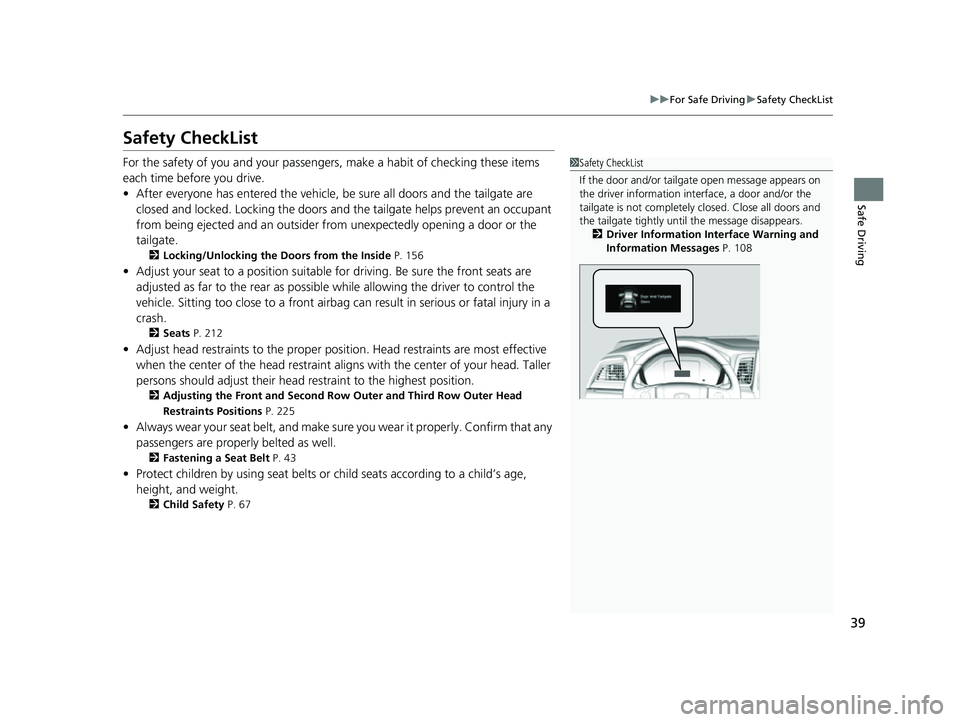
39
uuFor Safe Driving uSafety CheckList
Safe Driving
Safety CheckList
For the safety of you and your passengers, make a habit of checking these items
each time before you drive.
• After everyone has entered the vehicle, be sure all doors and the tailgate are
closed and locked. Locking the doors and the tailgate helps prevent an occupant
from being ejected and an outsider from unexpectedly opening a door or the
tailgate.
2 Locking/Unlocking the Doors from the Inside P. 156
•Adjust your seat to a position suitable for driving. Be sure the front seats are
adjusted as far to the rear as possible while allowing the driver to control the
vehicle. Sitting too close to a front airbag can result in serious or fatal injury in a
crash.
2 Seats P. 212
•Adjust head restraints to the proper position. Head restraints are most effective
when the center of the head restraint aligns with the center of your head. Taller
persons should adjust their head restraint to the highest position.
2 Adjusting the Front and Second Row Outer and Third Row Outer Head
Restraints Positions P. 225
•Always wear your seat belt, and make sure you wear it properly. Confirm that any
passengers are properly belted as well.
2 Fastening a Seat Belt P. 43
•Protect children by using seat belts or child seats according to a child’s age,
height, and weight.
2 Child Safety P. 67
1Safety CheckList
If the door and/or tailga te open message appears on
the driver information inte rface, a door and/or the
tailgate is not completely closed. Close all doors and
the tailgate tightly unti l the message disappears.
2 Driver Information Interface Warning and
Information Messages P. 108
23 US ODYSSEY-31THR6500.book 39 ページ 2022年1月24日 月曜日 午前11時35分
Page 42 of 707
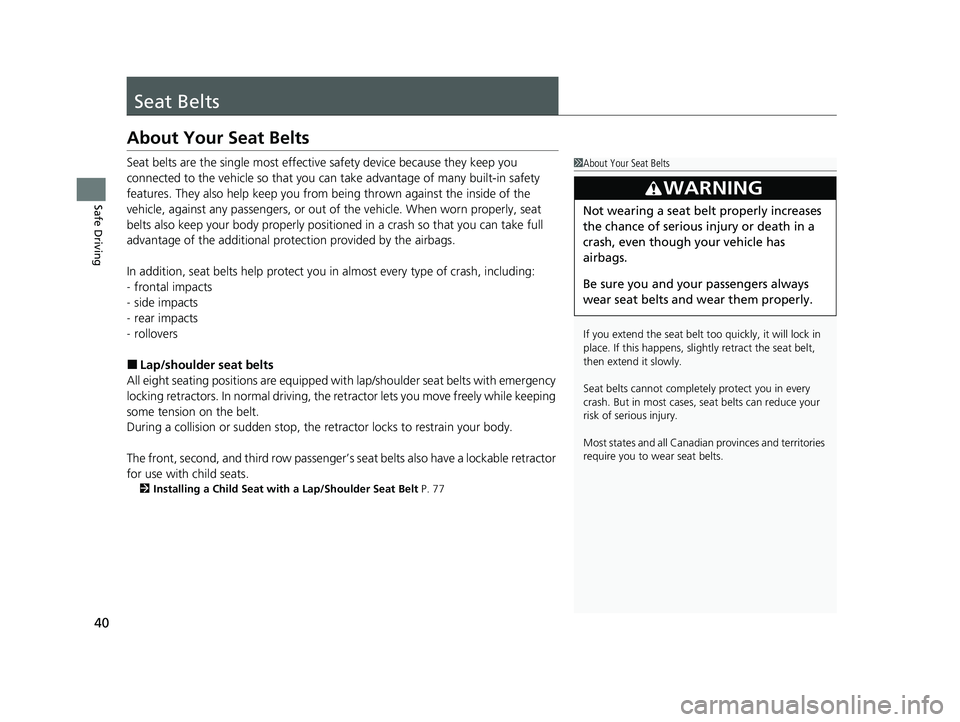
40
Safe Driving
Seat Belts
About Your Seat Belts
Seat belts are the single most effective safety device because they keep you
connected to the vehicle so that you can take advantage of many built-in safety
features. They also help keep you from be ing thrown against the inside of the
vehicle, against any passenger s, or out of the vehicle. When worn properly, seat
belts also keep your body pr operly positioned in a crash so that you can take full
advantage of the additional protec tion provided by the airbags.
In addition, seat belts help protect you in almost every type of crash, including:
- frontal impacts
- side impacts
- rear impacts
- rollovers
■Lap/shoulder seat belts
All eight seating positions are equipped wi th lap/shoulder seat belts with emergency
locking retractors. In normal driving, the re tractor lets you move freely while keeping
some tension on the belt.
During a collision or sudden stop, the retractor locks to restrain your body.
The front, second, and third row passenger’s seat belts also have a lockable retractor
for use with child seats.
2 Installing a Child Seat with a Lap/Shoulder Seat Belt P. 77
1About Your Seat Belts
If you extend the seat belt t oo quickly, it will lock in
place. If this happens, sli ghtly retract the seat belt,
then extend it slowly.
Seat belts cannot complete ly protect you in every
crash. But in most cases, seat belts can reduce your
risk of serious injury.
Most states and all Canadian provinces and territories
require you to w ear seat belts.
3WARNING
Not wearing a seat belt properly increases
the chance of serious injury or death in a
crash, even though your vehicle has
airbags.
Be sure you and your passengers always
wear seat belts and wear them properly.
23 US ODYSSEY-31THR6500.book 40 ページ 2022年1月24日 月曜日 午前11時35分
Page 43 of 707
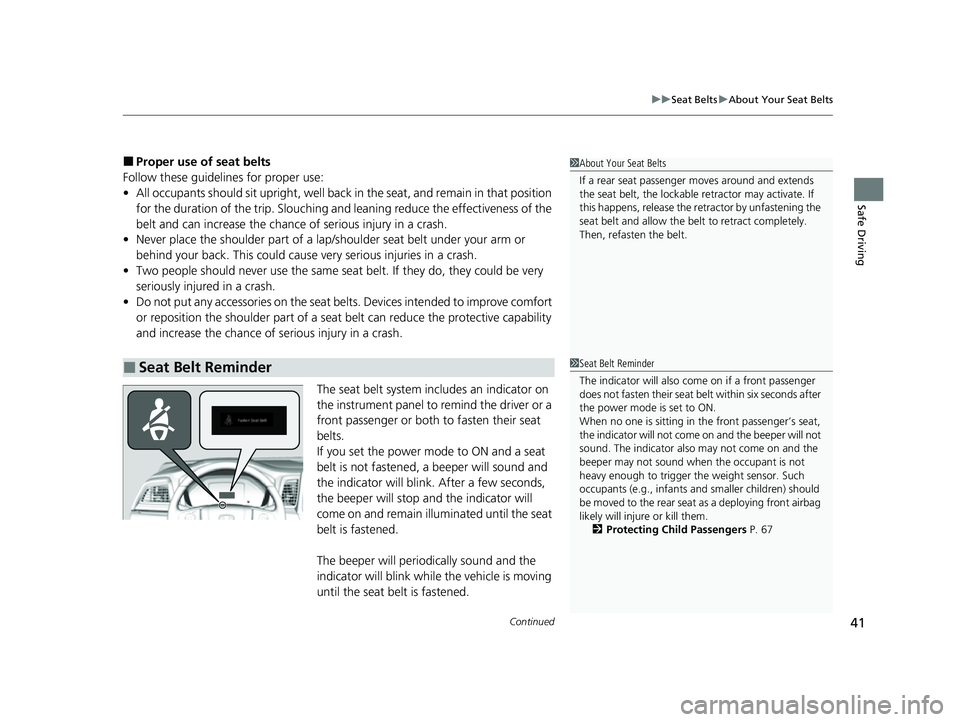
Continued41
uuSeat Belts uAbout Your Seat Belts
Safe Driving
■Proper use of seat belts
Follow these guidelines for proper use:
• All occupants should sit upright, well back in the seat, and remain in that position
for the duration of the trip. Slouching and leaning reduce the effectiveness of the
belt and can increase the chance of serious injury in a crash.
• Never place the shoulder part of a lap/shoulder seat belt under your arm or
behind your back. This could cause very serious injuries in a crash.
• Two people should never use the same seat belt. If they do, they could be very
seriously injured in a crash.
• Do not put any accessories on the seat be lts. Devices intended to improve comfort
or reposition the shoulder part of a seat belt can reduce the protective capability
and increase the chance of serious injury in a crash.
The seat belt system includes an indicator on
the instrument panel to remind the driver or a
front passenger or both to fasten their seat
belts.
If you set the power mode to ON and a seat
belt is not fastened, a beeper will sound and
the indicator will blink. After a few seconds,
the beeper will stop and the indicator will
come on and remain illuminated until the seat
belt is fastened.
The beeper will periodically sound and the
indicator will blink while the vehicle is moving
until the seat belt is fastened.
■Seat Belt Reminder
1About Your Seat Belts
If a rear seat passenger moves around and extends
the seat belt, the lockable retractor may activate. If
this happens, release the retractor by unfastening the
seat belt and allow the belt to retract completely.
Then, refasten the belt.
1Seat Belt Reminder
The indicator will also co me on if a front passenger
does not fasten their seat be lt within six seconds after
the power mode is set to ON.
When no one is sitting in th e front passenger’s seat,
the indicator will not come on and the beeper will not
sound. The indicator also may not come on and the
beeper may not sound when the occupant is not
heavy enough to trigger th e weight sensor. Such
occupants (e.g., infants and smaller children) should
be moved to the rear seat as a deploying front airbag
likely will injure or kill them. 2 Protecting Child Passengers P. 67
23 US ODYSSEY-31THR6500.book 41 ページ 2022年1月24日 月曜日 午前11時35分
Page 49 of 707
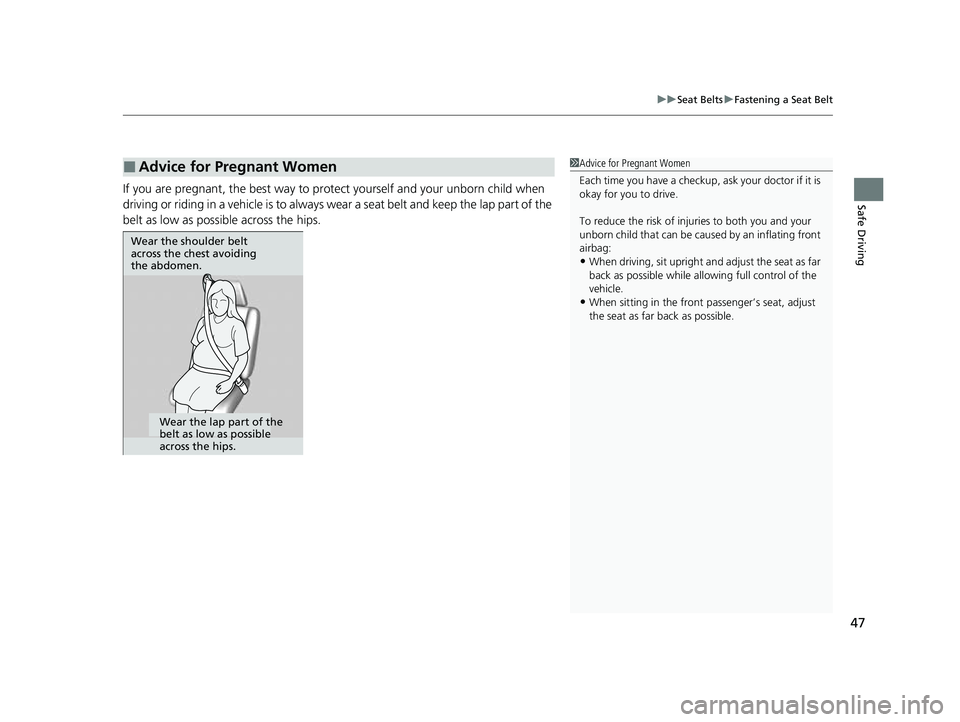
47
uuSeat Belts uFastening a Seat Belt
Safe DrivingIf you are pregnant, the best way to prot ect yourself and your unborn child when
driving or riding in a vehicle is to always wear a seat belt and keep the lap part of the
belt as low as possible across the hips.
■Advice for Pregnant Women1 Advice for Pregnant Women
Each time you have a checkup, ask your doctor if it is
okay for you to drive.
To reduce the risk of inju ries to both you and your
unborn child that can be caus ed by an inflating front
airbag:
•When driving, sit upright a nd adjust the seat as far
back as possible while allowing full control of the
vehicle.
•When sitting in the front passenger’s seat, adjust
the seat as far back as possible.
Wear the shoulder belt
across the chest avoiding
the abdomen.
Wear the lap part of the
belt as low as possible
across the hips.
23 US ODYSSEY-31THR6500.book 47 ページ 2022年1月24日 月曜日 午前11時35分
Page 57 of 707
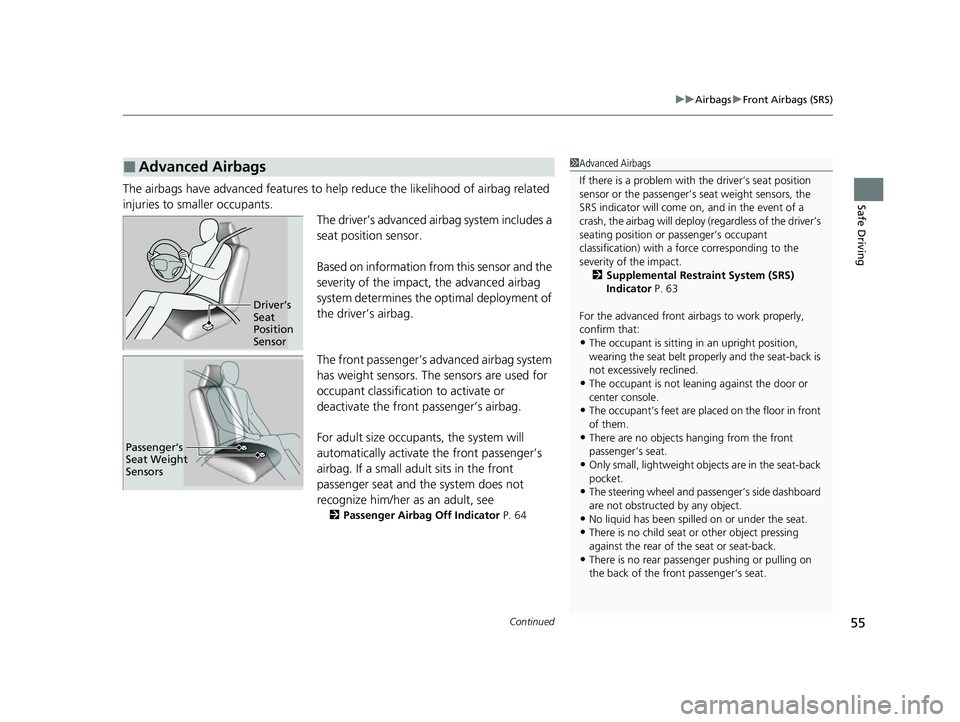
Continued55
uuAirbags uFront Airbags (SRS)
Safe DrivingThe airbags have advanced features to he lp reduce the likelihood of airbag related
injuries to smaller occupants. The driver’s advanced airbag system includes a
seat position sensor.
Based on information from this sensor and the
severity of the impact, the advanced airbag
system determines the optimal deployment of
the driver’s airbag.
The front passenger’s ad vanced airbag system
has weight sensors. The sensors are used for
occupant classification to activate or
deactivate the front passenger’s airbag.
For adult size occupant s, the system will
automatically activate the front passenger’s
airbag. If a small adult sits in the front
passenger seat and the system does not
recognize him/her as an adult, see
2 Passenger Airbag Off Indicator P. 64
■Advanced Airbags1Advanced Airbags
If there is a problem with the driver’s seat position
sensor or the passenger’s s eat weight sensors, the
SRS indicator will come on, and in the event of a
crash, the airbag will deploy (regardless of the driver’s
seating position or passenger’s occupant
classification) with a force corresponding to the
severity of the impact. 2 Supplemental Restraint System (SRS)
Indicator P. 63
For the advanced front airbags to work properly,
confirm that:
•The occupant is sitting in an upright position,
wearing the seat belt prope rly and the seat-back is
not excessively reclined.
•The occupant is not leaning against the door or
center console.
•The occupant’s feet are plac ed on the floor in front
of them.
•There are no objects ha nging from the front
passenger’s seat.
•Only small, lightweight objects are in the seat-back
pocket.
•The steering wheel and passenger’s side dashboard
are not obstructed by any object.
•No liquid has been spille d on or under the seat.•There is no child seat or other object pressing
against the rear of the seat or seat-back.
•There is no rear passenger pushing or pulling on
the back of the front passenger’s seat.
Driver’s
Seat
Position
Sensor
Passenger’s
Seat Weight
Sensors
23 US ODYSSEY-31THR6500.book 55 ページ 2022年1月24日 月曜日 午前11時35分